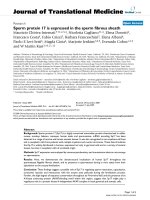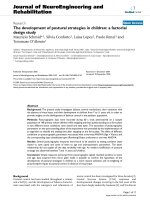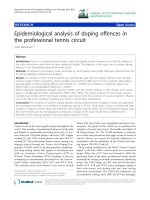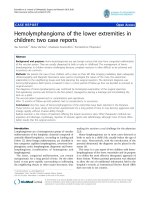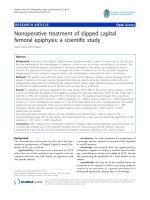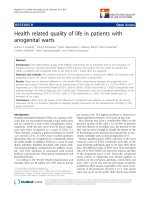Báo cáo hóa học: " Thrombolysis for massive pulmonary embolism in pregnancy: a case report" ppt
Bạn đang xem bản rút gọn của tài liệu. Xem và tải ngay bản đầy đủ của tài liệu tại đây (1.58 MB, 6 trang )
CASE REP O R T Open Access
Thrombolysis for massive pulmonary embolism in
pregnancy: a case report
Sergio Fasullo
1
, Giorgio Maringhini
1
, Gabriella Terrazzino
1,2
, Filippo Ganci
1
, Salvatore Paterna
2
and
Pietro Di Pasquale
1*
Abstract
Mortality from pulmonary embolism (PE) in pregnancy might be related to challenges in targeting the right
population for prevention. Such targeting could help ensure that the correct diagnosis is suspected and
adequately investigated, and allow the initiation of the timely and best possible treatment of this disease. In the
literature to date only 18 case reports of thrombolysis in pregnant women with PE have been reported, and
showed beneficial effects for both mother and fetus in terms of mortality and complications with acceptable
bleeding risks. We present here the case of a pregnant patient with massive PE who underwent successful
thrombolysis. A 26-year-old pregnant (at 24 weeks) woman was admitted 4 h after onset of sudden acute dyspnea
and chest pain. An immediate electrocardiogram showed a typical S1-Q3-T3 pattern. The echocardiogram showed
a distended right ventricle with free-wall hypokinesia and displacement of the interventricular septum toward the
left ventricle. Thrombolysis with recombinant tissue plasminogen activator (alteplase 10 mg bolus, then 90 mg over
2 h) was ad ministered. Pelvic examination and ultrasound showed regular fetal heart beat, and regular placental
and liquid presence. No problems developed for the mother or fetus in the subsequent days or at discharge. In
conclusion, in pregnant patients with life-threatening massive PE, thrombolytic therapy can be administer ed, and
the use of echocardiographic, laboratory, and clinical data can be useful tools to achieve a rapid diagnosis and
make a therapeutic decision, but additional studies need to be performed to further define its use.
Introduction
Massive pulmonary embolism (MPE) is the leading
cause of maternal mortality in the developed world.
Mortality from PE in pregnancy might be related to
challenges in targeting the right population for pre ven-
tion. Such targeting could help ensure that the correct
diagnosis is suspected and adequately i nvestigated, and
allow the initiation of the timely and best possible treat-
ment of this disease. Thrombolytic drugs can be consid-
ered for the treatment of patients who are
hemodynamically unstable, or of patients with refractory
hypoxemia [1] or right ventricular dysfunction on echo-
cardiogram [2,3]. However, the high risk of major bleed-
ing (in 4%-14% of treated patients with thrombolysis)
limits their use [4]. Although pregnancy-specific compli-
cations do arise, including spontaneous pregnancy loss,
placental abruption, and preterm l abor, it is not clear
whether they are caused by the underlying disease, its
treatment, or neither. We present here the case of a
pregnant patient with massive PE (MPE) who was hospi-
talized 4 h after onset of sudden acute dyspnea and
chest pain, and successfully thrombolysed.
Case report
A 26-year-old pregnant (at 24 weeks) woman was
referred to the emergency department (ED) of o ur hos-
pital ("G.F. Ingrassia” Palermo, Italy) 4 h after onset of
sudden acute dyspnea and chest pain. No risk factors or
drug consumption was present in the patient’sclinical
history. On admission to the ED, the patient was dys-
pneic, cyanotic, hemodynamically unstable, hypotensive
(70/50 mmHg), and tachycardic (125 beats/min), with
lowoxygensaturation(80%)inoxygenwithaVenturi
mask (6 L/min), with a respiratory rate of 28-30
breaths/min, and with primary hypoxemia and metabolic
acidosis (pH 7.29; PO
2
51 mmHg, PCO
2
30 mmHg,
HCO
3
20 mmol/L).
* Correspondence:
1
Division of Cardiology, “Paolo Borsellino” G.F. Ingrassia Hospital, Palermo,
Italy
Full list of author information is available at the end of the article
Fasullo et al. International Journal of Emergency Medicine 2011, 4:69
/>© 2011 Fasullo et al; licensee Springer. This is an Open Access article distributed under the terms of the Creative Commons Attribution
License (http://creativecom mons.org/licenses /by/2.0), which permits unrestricted use, distribution, and reproduction in any medium,
provided the original work is properly ci ted.
Immediate electrocardiogram showed sinus tachycar-
dia with a typical S1-Q3-T3 pattern (Figure 1). After
first aid consisting of intravenous line placement, oxygen
treatment, and fluid infusion, the patient was transferred
to the cardiology department with a diagnosis of MPE
comp licated by shock. Plasma samples were obtained to
check laboratory parameters including troponin I, pro-
thrombin time, activated partial thromboplastin time,
72 h after
Figure 1 ECG on admission, before thrombolysis and 72 h after thrombolysis.
Fasullo et al. International Journal of Emergency Medicine 2011, 4:69
/>Page 2 of 6
INR, fibrin degradation products, D-dimers, and fibrino-
gen and N-terminal pro brain natriuretic peptide plasma
levels, which were controlledevery6hforthefirst24
h, then every 12 h until c linical stabilization and every
24 h subsequently (Table 1). The echocardiogram per-
formed on admission showed a normally contracting left
ventricle, a distended right ventricle with free-wall hypo-
kinesia, and displ acement of the interventricular septum
toward the left ventricle. In addition, a severe tricuspid
regurgitation, pulmonary arterial hypertension (accelera-
tion time < 90 ms with bifid pattern), and inferior vena
cava dilatation (26 mm) were present (Figure 2). S piral
computed tomography was not performed because of
the pregnancy, and for the same reason, catheter embo-
lectomy was not used. To decide on the diagnosis and
treatment, we use d only clinical , laboratory, and echo-
cardiographic findings. In a patient with suspected MPE
who is in critical condition, bedside echocardiography is
particularly helpful in emergency management decisions
[3], but in the present case, the presence of pregnancy
discouraged performing invas ive imaging tests or t reat-
ments. Although there was a relative contraindication to
thrombolysis [5], it was no longer relevant in the face of
an extremely life-threatening situation for the mother
and fetus. After informing the patient and obtaining
written consent, thrombolytic treatment was carried out
with rtPA (10 mg bolus, then 90 mg over 2 h) and a
heparin bolus (5, 000 IU) with subsequent heparin infu-
sion (1, 000 U/h), or according to partial thromboplastin
time for the first 48 h, when LMWH (enoxaparin 6, 000
IU twice daily) was started [ 6]. Arterial blood gas eva-
luation was also performed every 30 min after thrombo-
lytic treatment, and then every 6 h up to stabilization.
An improvement in oxygen saturation (> 90%), an
increase in blood pressure, a reducti on in hea rt rate, a
complete absence of cyanosis, and a reduction in dys-
pnea 30 min after thrombolysis were observed. Two
hours after thrombolysis, we observed a heart rate < 100
beats/min, 98% saturation, pH 7.39; PO
2
95 mmHg,
PCO
2
34 mmHg, HCO
3
23 mmol/L, and a blood pres-
sure of 95/60 mmHg. The same day (4 h after thrombo-
lysis), a pelvic examination was performed, and
ultrasound showed a regular fetal heart beat, regular
placental and normal liquid presence (Figure 1). A gyne-
cological visit and ultrasound control were carried out
two times/day (morning and afternoon) until discharge.
In addition, we observed an increase in TN I (3.7 pg/ml)
and BNP (375 pg/ml), which returned to the normal
range 72 h after thrombolysis. The subsequent day,
ultrasonography did not show any vein thrombosis.
Echocardiogram repeated again 24 to 48 h from throm-
bolysis showed a clear improvement of the hemody-
namics of the right ventricle, disappearance of
dilatation, normalization o f pulmonary pressures, nor-
malization of septal motion, and reduction of vena cava
diameter (20 mm after 48 h and 16 mm after 72 h). The
S1-Q3-T3 was no longer present in the electrocardio-
gram 72 h after thrombolysis (Figure 1). On the 5th day,
the patient was transferred from intensive care and dis-
charged 8 days after. No problems developed in the sub-
sequent days for the mother and fetus, which was
controlled every day and before discharge. In the first 36
h we observed a modest Hb reduction (about 1 g), and
the plasma level of fibrinogen in plasma was very low,
almost undetectable.
and the plasma fibrinogen was undosable, while the
other hematological parameters were in normal range.
No blood transfusions were required. The plasma fibri-
nogen returned to the normal range 48 h after thrombo-
lysis. The hemoglobin increased in the subsequent days
up to 11.5 g. No minor or major bleeding was observed,
and the placental and fetal examination was always nor-
mal. All laboratory parameters were normalized at dis-
charge. In addition, during hospitalization a selective
study of the coagulation at the hematological clinic of
the University of Palermo was a lso performe d, and
important alterations were not found. The patient was
discharged and underwent LMWH treatment (Figure 3).
The patient is being followed up at our outcome clinic,
tog ether with a gynec olog ist, to evaluate the fetal status
and develop subsequent strategies, also for postpartum.
Discussion
Women who are pregnant or in the postpartum period
as well as women receiving hormonal therapy are at
increased risk for venous thromboembolism. Venous
thromboembolism is responsible for up to 15% of all in-
hospital deaths, and it also accounts for 20% to 30% of
deaths associated with pregnancy and delivery in the
United States and Europe. In pregnant patients with
suspected acute PE, the use of noninvasive diagnostic
Table 1 Clinical and laboratory parameters in the first 72
h after admission.
Entry 2 h 72 h
BP mmHg 70/50 95/60 110/70
HR beats/min 125 98 82
OS (6 L/min O2) 80% 98 (6 L/min O
2
) 99% room air
RR breaths/min 28-30 22 16
pH 7.29 7.39 7.44
PO
2
mmHg 51 95 99
PCO
2
mmHg 30 34 40
HCO
3
mmol/L 20 23 24
ECG S1-Q3-T3 Disappeared
TNI pg/mL 3.7 < 0.02
BNP pg/mL 375 < 100
BP, blood pressure; HR, heart rate; OS, oxygen saturation; RR, respiratory rate.
Fasullo et al. International Journal of Emergency Medicine 2011, 4:69
/>Page 3 of 6
methods without imaging may seem ideal, but concern
about exposure to radiation should not deter clinicians
from using computed tomography angiography or venti-
lation-perfusion scanning when necessary. Although
experience with thrombolytic therapy in pregnancy is
limited (only 18 cases treated with different thromboly-
tic drugs have been reported), the use of thr ombolytic
agents may be lifesaving in patients with MPE and
severe hemodynamic compromise [7-14]. In these 18
case reports of pregnant women treated with systemic
thrombolysis for MPE, the most commonly used regi-
men during pregnancy was 100 mg tPA over 2 h (10
patients), while 6 patients received STK and 2 urokinase.
Concerning complication rates in pregnant women
(major nonfatal bleeding), only 4 of 18 cases were
observed in the streptokinase group. In addition, pre-
term delivery occurred in two patients with tPA and
three in the streptokina se group. Two child deaths were
reported (1 in the streptokinase and 1 in the tPA
group), but they were not attributed to fetal hemorrhage
[7-14]. There is concern that thrombolytic therapy will
lead to placental abruption, but this co mplication has
not been reported. The care of the pregnant patient
who has MPE either at term or when suspicion of com-
promised fetal status calls for expeditious cesarean deliv-
ery is complex and requires a coordinated treatment
strategy by the obstetrician, intensivist, cardiothoracic
surgeon, anesthesiologist, and interventional radiolo gist.
The approach to the ma nagement of a n MPE should be
individualized and adapted tochangingcircumstances.
Although thrombolytic therapy is considered to be (rela-
tively) contraindicated, successful outcomes with the use
of thrombolytic therapy during labor have been reported
[15,16]. We report the case of a 26-year-old pregnant
(at 24 weeks) woman with MPE who was successfully
treated with thrombolysis. We used rTPA because this
fibrinolytic agent does not cross the placental barrier.
We recognize that thrombolysis can be dangerous in the
early phases o f pregnancy, but the urgen cy of the case
required a quick decision. In addition, we also showed
Figure 2 On admission: right ventricular dysfunction and fetus echocardiogram 4 h after thrombolysis.
Fasullo et al. International Journal of Emergency Medicine 2011, 4:69
/>Page 4 of 6
that the echocardiogram and clinical and laboratory
parameters were invaluable tools to reach a rapid cor-
rected diagnosis, allowing us also to follow the effects of
treatment. This choice avoided using possibly dangerous
radiant imaging tools on the fetus. In addition, accord-
ing to ESC guidelines, in mothers the overall incidence
of bleeding is about 8%, usually from the genital tract.
This risk does not seem unreasonable compared with
the death rate seen in patients with massive PE treated
with heparin alone [5]. In conclusion, in a patient with
life-threatening PE, thrombolytic therapy should not be
withheld solely because of pregnancy, but additional stu-
dies need to be performed to further define its use.
Consent
the consent of the publication of scientific work has
been signed.
Author details
1
Division of Cardiology, “Paolo Borsellino” G.F. Ingrassia Hospital, Palermo,
Italy
2
Department of Emergency Medicine, University of Palermo, Palermo,
Italy
Figure 3 Predischarge (7 days): right ventricle function normalization.
Fasullo et al. International Journal of Emergency Medicine 2011, 4:69
/>Page 5 of 6
Authors’ contributions
SF and PDP conceived of the study. PDP and SP drafted the manuscript.
GM, GT and FG participated in the sequence alignment. All authors read and
approved the final manuscript.
Competing interests
The authors declare that they have no competing interests.
Received: 11 March 2011 Accepted: 31 October 2011
Published: 31 October 2011
References
1. Buller HR, Agnelli G, Hull RD, Hyers TM, Prins MH, Raskob GE:
Antithrombotic therapy for venous thromboembolic disease: the
Seventh ACCP Conference on Antithrombotic and Thrombolytic
Therapy. Chest 2004, 126:401S-28.
2. Konstantinides S, Geibel A, Heusel G, Heinrich F, Kasper W: Heparin plus
alteplase compared with heparin alone in patients with submassive
pulmonary embolism. N Engl J Med 2002, 347:1143-50.
3. Fasullo S, Scalzo S, Maringhini G, Ganci F, Cannizzaro S, Basile I, Cangemi D,
Terrazzino G, Parrinello G, Sarullo FM, Baglin R, Paterna S, Di Pasquale P: Six-
Month Echocardiographic Study in Patients With Submassive Pulmonary
Embolism and Right Ventricle Dysfunction: Comparison of Thrombolysis
With Heparin. Am J Med Sci 2011, 341(1):33-9.
4. Stein PD, Hull RD, Raskob G: Risks for major bleeding from thrombolytic
therapy in patients with acute pulmonary embolism: consideration of
noninvasive management. Ann Intern Med 1994, 121:313-7.
5. Torbicki A, Perrier A, Konstantinides S, Torbicki A, Perrier A, Konstantinides S,
Agnelli G, Galiè N, Pruszczyk P, Bengel F, Brady AJ, Ferreira D, Janssens U,
Klepetko W, Mayer E, Remy-Jardin M, Bassand JP, ESC Committee for
Practice Guidelines (CPG): Guidelines on the diagnosis and management
of acute pulmonary embolism: the Task Force for the Diagnosis and
Management of Acute Pulmonary Embolism of the European Society of
Cardiology (ESC). Eur Heart J 2008, 29:2276-315.
6. Bourjeily G, Paidas M, Khalil H, Rosene-Montella K, Rodger M: Pulmonary
embolism in pregnancy. Lancet 2010, 375:500-12.
7. Leonhardt G, Gaul C, Nietsch HH, Buerke M, Schleussner E: Thrombolytic
therapy in pregnancy. J Thromb Thrombolysis 2006, 21:271-6.
8. Huang WH, Kirz DS, Gallee RC, Gordey K: First trimester use of
recombinant tissue plasminogen activator in pulmonary embolism.
Obstet Gynecol 2000, 96:838.
9. Ahearn GS, Hadjiliadis D, Govert JA, Tapson VF: Massive pulmonary
embolism during pregnancy successfully treated with recombinant
tissue plasminogen activator: a case report and review of treatment
options. Arch Intern Med 2002, 162:1221-7.
10. Trukhacheva E, Scharff M, Gardner M, Lakkis N: Massive pulmonary
embolism in pregnancy treated with tissue plasminogen activator.
Obstet Gynecol 2005, 106:1156-8.
11. Fasullo S, Scalzo S, Maringhini G, Cannizzaro S, Terrazzino G, Paterna S, Di
Pasquale P: Thrombolysis for massive pulmonary embolism in
pregnancy: a case report. Am J Emerg Med .
12. Doreen te Raa G, Ribbert LSM, Snijder RJ, Besma DH: Treatment options in
massive pulmonary embolism during pregnancy; a case report and
review of literature. Thrombosis Research 2009, 124:1-5.
13. Holden EL, Ranu H, Sheth A: Thrombolysis for massive pulmonary
embolism in pregnancy. A report of three cases and follow up over a
two year period. Thromb Res 2010.
14. Lonjaret L, Lairez O, Galinier M, Minville V: Thrombolysis by recombinant
tissue plasminogen activator during pregnancy: a case of massive
pulmonary embolism. Am J Emerg Med .
15. Fagher B, Ahlgren M, Astedt B: Acute massive pulmonary embolism
treated with streptokinase during labor and the early puerperium. Acta
Obstet Gynecol Scand
1990, 69:659-61.
16. Hall RJ, Young C, Sutton GC, Cambell S: Treatment of acute massive
pulmonary embolism by streptokinase during labour and delivery. BMJ
1972, 4:647-9.
doi:10.1186/1865-1380-4-69
Cite this article as: Fasullo et al.: Thrombolysis for massive pulmonary
embolism in pregnancy: a case report. International Journal of Emergency
Medicine 2011 4:69.
Submit your manuscript to a
journal and benefi t from:
7 Convenient online submission
7 Rigorous peer review
7 Immediate publication on acceptance
7 Open access: articles freely available online
7 High visibility within the fi eld
7 Retaining the copyright to your article
Submit your next manuscript at 7 springeropen.com
Fasullo et al. International Journal of Emergency Medicine 2011, 4:69
/>Page 6 of 6
